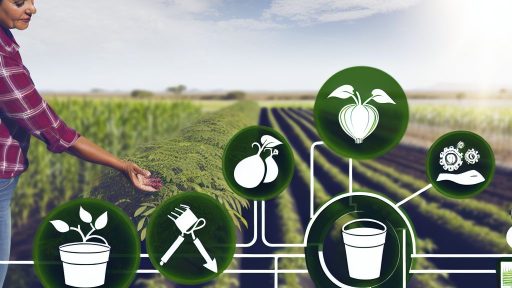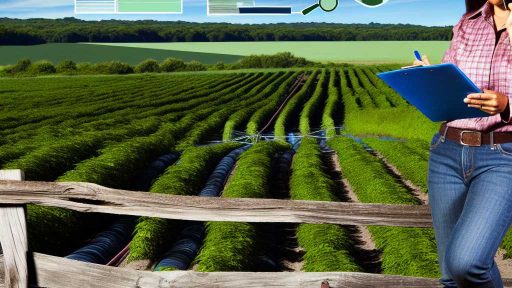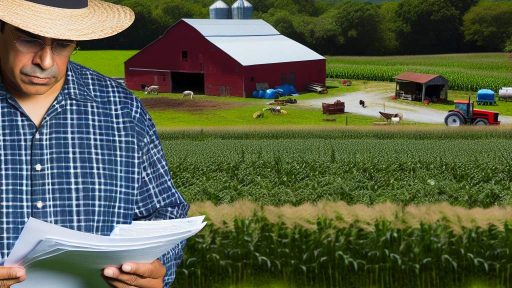Understand the Different Types of Agricultural Insurance Available
Crop Insurance
Crop insurance protects farmers against financial loss due to plant disease, drought, or other disasters.
There are two main types: Actual Production History (APH) and Revenue Protection (RP).
APH pays for losses based on previous production history.
RP covers loss based on revenue decline compared to previous years.
Livestock Insurance
Livestock insurance provides coverage for cattle, pigs, sheep, and other livestock.
This type of insurance safeguards against loss from death or disease.
It also helps with price fluctuations in livestock markets.
Farm Business Insurance
Farm business insurance covers risks associated with operating a farm.
This includes general liability and property coverage for farm structures.
It protects against loss due to theft, fire, or other unforeseen events.
Specialized Insurance Options
Specialized insurance options are available for specific crops or livestock.
These include hail insurance for crops and mortality insurance for livestock.
Investing in these policies can provide additional security.
Assess the Specific Risks Associated with Your Agricultural Operations
Understanding Risks in Agriculture
Each agricultural operation faces unique risks.
These risks can stem from natural, economic, or operational factors.
Transform Your Agribusiness
Unlock your farm's potential with expert advice tailored to your needs. Get actionable steps that drive real results.
Get StartedIdentification of these risks is the first crucial step.
It helps farmers prepare and make informed decisions.
Natural Risks
Natural risks include weather-related events.
Droughts and floods can severely impact crop yields.
Additionally, pests and diseases pose a significant threat.
Understanding local climate conditions aids in preparation.
Economic Risks
Fluctuations in market prices impact profitability.
Additionally, rising input costs can strain budgets.
Staying informed about market trends is essential.
Establishing a financial cushion can mitigate economic impacts.
Operational Risks
Operational risks involve management and labor issues.
For instance, equipment failures can disrupt productivity.
Furthermore, shortages in skilled labor can hinder operations.
Implementing regular maintenance can reduce equipment risks.
Conducting a Risk Assessment
A formal risk assessment is beneficial for farmers.
This process involves evaluating potential risks systematically.
Use checklists and tools to identify vulnerabilities.
Document findings and prioritize risks based on severity.
Consulting Experts
Consulting with agricultural experts can provide insights.
Professionals can help analyze risks specific to your operation.
Valuable advice will equip farmers with effective strategies.
Networking with industry peers can also enhance knowledge.
Gather Necessary Documentation and Financial Records
Identify Required Documentation
Begin by identifying all necessary documents for your application.
Your agricultural insurance provider will specify required paperwork.
Showcase Your Farming Business
Publish your professional farming services profile on our blog for a one-time fee of $200 and reach a dedicated audience of farmers and agribusiness owners.
Publish Your ProfileCommonly required documents include proof of ownership, farm maps, and crop details.
Check with providers like Green Acres Insurance for any additional requirements.
Organize Financial Records
Next, organize your financial statements for the application process.
Prepare income statements, balance sheets, and cash flow statements.
Maintain accurate records for at least the past three years.
This will demonstrate financial health to the insurance provider.
Compile Proof of Previous Claims
If applicable, compile documentation of any previous claims.
These documents can validate your history with insurance claims.
Providers may review past claims to assess risk factors.
Consider gathering correspondence from past insurers for reference.
Gather Certifications and Licenses
Ensure you have all necessary agricultural certifications on hand.
Licenses may include pesticide applicator licenses or organic certifications.
These documents enhance your credibility as a responsible farmer.
Consult with Financial Advisors
Before submission, consult with financial advisors or accountants.
They can help verify the accuracy of your financial records.
Additionally, they may identify any missing documentation.
Take their feedback seriously to improve your application quality.
Explore Further: Water Conservation Strategies In Agricultural Policies
Research and Compare Insurance Providers and Their Policies
Identifying Insurance Providers
Start by identifying different agricultural insurance providers.
Look for both local and national companies.
Each provider may offer unique policies tailored to different needs.
Review their reputations and customer feedback.
Understanding Policy Types
Insurance policies vary widely, so understand what is available.
Common types include crop, livestock, and farm property insurance.
Each policy covers specific risks associated with farming.
Research the benefits and downsides of each policy type.
Comparing Coverage Options
Once you know the providers, compare their coverage options.
Take note of the levels of protection offered by each policy.
Look at exclusions and limitations that may apply.
This helps you identify policies that fit your specific needs.
Evaluating Premiums and Deductibles
Next, evaluate premiums and deductibles for each policy.
Premiums determine how much you will pay for coverage.
Lower premiums may mean higher deductibles and vice versa.
Choose a balance that works best for your budget.
Seeking Professional Advice
If you feel overwhelmed, consider seeking professional advice.
Insurance agents can provide insights into different policies.
They can help you navigate the fine print and details.
This step often leads to better-informed decisions.
Gathering Quotes
Request quotes from multiple providers for comparison.
Ensure the quotes align with the coverage options you seek.
Showcase Your Farming Business
Publish your professional farming services profile on our blog for a one-time fee of $200 and reach a dedicated audience of farmers and agribusiness owners.
Publish Your ProfileThis process helps to find the most affordable rates.
Take your time to review each quote thoroughly.
Gain More Insights: Top Renewable Energy Tax Credits Available to Farmers
Steps to Apply for Agricultural Insurance Coverage
Complete a Comprehensive Application Form
To begin, gather all necessary documents relevant to your agricultural operations.
Ensure you have your farm’s details ready, including location and size.
Next, fill out the application form accurately.
Be thorough and honest about your farming activities and practices.
Provide precise data about your crops or livestock for accurate coverage.
Additionally, include information about previous insurance claims, if any.
Review the form to confirm all entries are correct before submitting.
Submitting a well-completed form improves the chances of faster processing.
Include Required Supporting Documents
Attach necessary documents to support your application.
This may include tax returns, farm production records, and past insurance policies.
These documents substantiate your claims and provide clarity to the insurer.
Make sure all documents are up-to-date and clearly legible.
Consider reaching out to your insurance agent for guidance on required documents.
Understand the Coverage Options
Familiarize yourself with the different types of agricultural insurance available.
Policies can vary significantly based on crops or livestock insured.
Explore options such as crop insurance, livestock insurance, and liability coverage.
Each type of insurance caters to specific needs and circumstances.
Assess what risks you want to insure and choose accordingly.
Consult with an Insurance Agent
Engaging with a knowledgeable insurance agent is crucial for understanding your options.
An agent can clarify policy details and answer specific questions.
They also assist in customizing a policy to meet your farm’s unique needs.
Don’t hesitate to ask for examples of similar coverage solutions.
Additionally, ensure you understand the costs and payment options available.
Submit Your Application
Once satisfied with your application and documentation, submit them promptly.
Keep copies of all documents for your records and follow submission guidelines.
After submission, monitor the status of your application with the insurer.
Be prepared to provide further information if requested.
Staying proactive can help expedite the approval process.
See Related Content: Impact Of Trade Policies On Sustainable Agriculture Development

Consult with an Insurance Agent for Personalized Advice and Assistance
Determine Your Coverage Needs
Identify the specific risks your agricultural operation faces.
Consider factors like crop types and production methods.
Next, evaluate your existing insurance policies.
This will help you understand what additional coverage you may require.
Find a Qualified Insurance Agent
Look for an insurance agent who specializes in agricultural insurance.
Ask for recommendations from fellow farmers or agricultural associations.
Verify the agent’s credentials and experience in the field.
Schedule an Initial Consultation
Contact your chosen agent to set up a meeting.
Showcase Your Farming Business
Publish your professional farming services profile on our blog for a one-time fee of $200 and reach a dedicated audience of farmers and agribusiness owners.
Publish Your ProfilePrepare a list of questions and concerns to discuss during this meeting.
Share details about your farming operations and financial goals.
Explore Coverage Options
Your agent will present various insurance policies suitable for you.
Review each option’s features, benefits, and costs carefully.
Make sure to understand the terms, conditions, and exclusions associated with each policy.
Request Quotes and Compare Plans
Ask your agent for detailed quotes on the policies you’re considering.
Compare these quotes to determine the best value for your needs.
Consider both premiums and deductibles in your comparison.
Finalize Your Choice
Once you’ve selected a policy, inform your agent.
Complete any required paperwork to secure your coverage.
Make sure to retain copies of all documents for your records.
Schedule Annual Reviews
Insurance needs can change over time, so schedule yearly reviews.
Your agent can help you assess whether your coverage remains appropriate.
Stay updated on new policies or changes in your agricultural environment.
Uncover the Details: Farm-To-Table Policies and Their Role in Sustainable Agricultural Practices
Review the Terms and Conditions of the Insurance Policy Carefully
Understanding the terms and conditions is crucial before applying for insurance coverage.
Start by reading the entire policy document thoroughly.
Look for specific coverage areas relevant to your agricultural needs.
Pay close attention to exclusions that might affect your coverage.
Note any waiting periods outlined in the policy.
This will help you understand when coverage starts.
Examine any deductibles you may have to pay in case of a claim.
Determine the claim process described in the policy.
This information is vital for smooth claims in the future.
Check if the policy covers both crop and livestock insurance.
Different types of coverage might be necessary based on your operation.
Identify the limits of liability stated in the policy.
These limits dictate how much you can claim in case of loss.
Contact the insurance provider for clarification on any confusing terms.
This proactive step can prevent misunderstandings later.
Additionally, seek advice from experienced farmers who have similar policies.
Their insights can provide valuable perspectives on your chosen coverage.
Finally, ensure that the policy aligns with your farm’s financial goals.
This oversight will help protect your investment effectively.
Submitting the Application and Following Up for Confirmation of Coverage
Preparing the Application
Before you submit your application, gather all necessary documents.
Ensure that you have your farm’s identification details ready.
In addition, include information about your crops or livestock.
Double-check the requirements of your agricultural insurance provider.
Filling Out the Application
Complete the application form accurately.
Use clear and concise language throughout the process.
Showcase Your Farming Business
Publish your professional farming services profile on our blog for a one-time fee of $200 and reach a dedicated audience of farmers and agribusiness owners.
Publish Your ProfileIf needed, consult with an insurance agent for clarification.
Submit any required financial statements to support your requests.
Submitting the Application
Choose the appropriate method for submission.
You may submit the application online or via mail.
Keep a copy of your application for your records.
Confirm that the application was received by the provider.
Following Up
After submission, follow up with the insurance company.
Contact their customer service to inquire about your application status.
Ask for a timeline regarding the confirmation of coverage.
Keep records of your communication with the provider.
Receiving Confirmation
Once processed, expect to receive confirmation of your coverage.
The confirmation will detail the terms and conditions of your policy.
Review the details carefully to ensure everything is accurate.
If discrepancies arise, contact the insurance provider immediately.
Making Adjustments
You may need to make adjustments to your coverage later on.
Monitor your farming activities and risk levels regularly.
Consult with your insurance agent to discuss potential changes.
Submit any modifications in writing to ensure coverage clarity.




